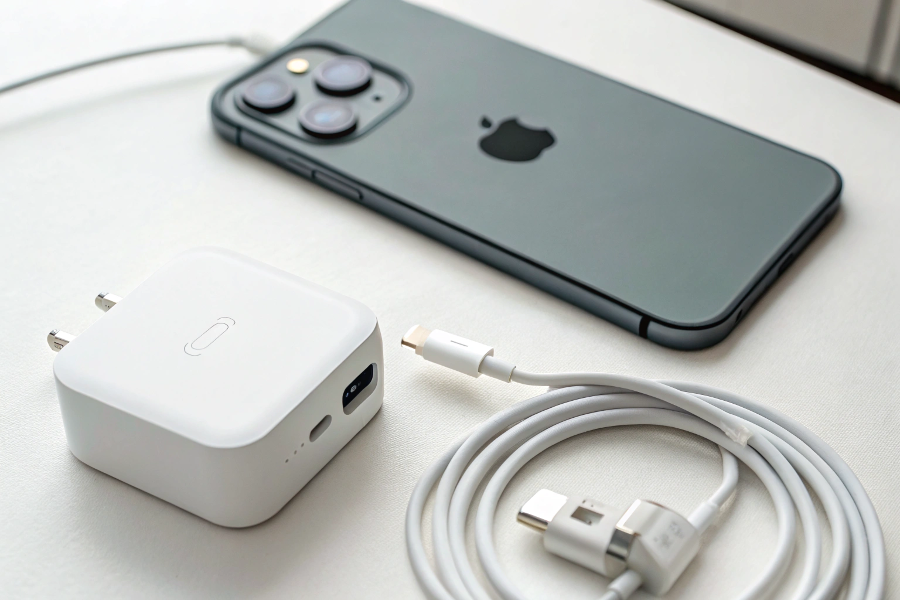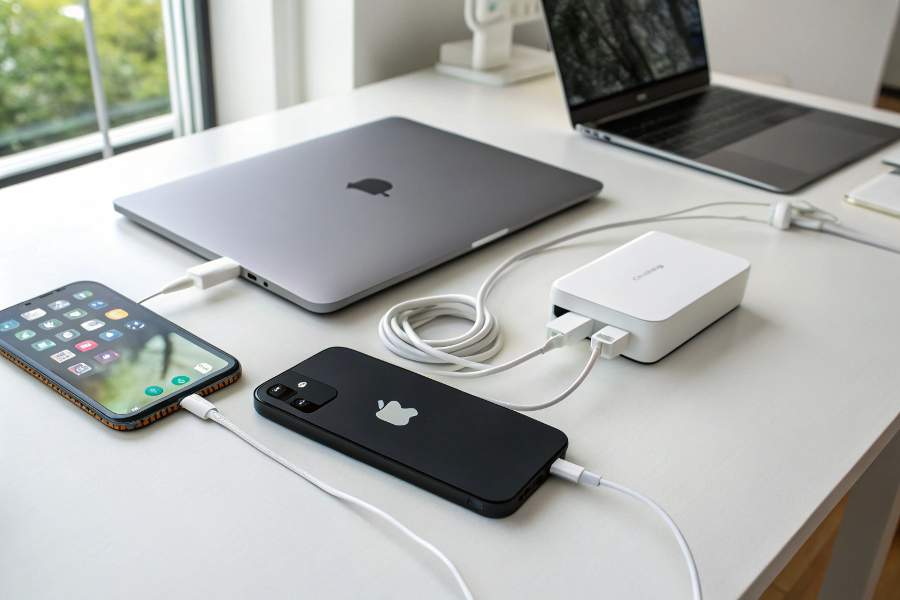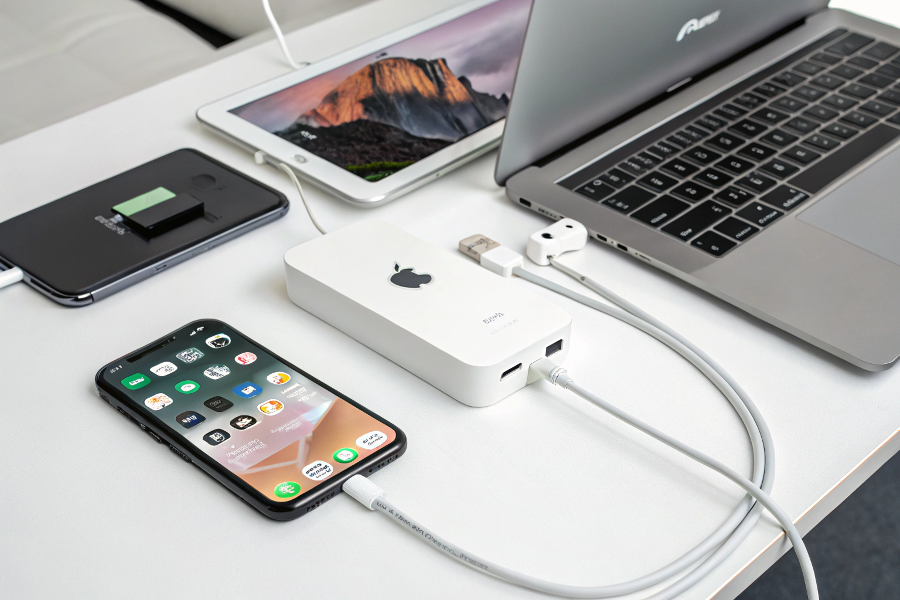Feeling a bit confused with Apple switching things up? You see "USB-C" everywhere now, even for iPhones. Buying the wrong charger or cable is frustrating and wastes money, so let’s clear things up.
A Type-C charger for iPhone is simply a power adapter that uses the modern, oval-shaped USB-C port to deliver power. For newer iPhones (iPhone 15 and later), you plug a USB-C to USB-C cable directly into the phone. It enables faster charging and uses the same connector as many other modern devices.

This change from the old Lightning port might seem sudden, but it brings some real advantages. Understanding this shift is important, especially for buyers like David who need to source the right accessories for their customers. Let’s explore why this change happened and what it means for you.
Why did Apple switch iPhones to USB-C?
Used Apple’s Lightning cable for years and now suddenly it’s USB-C? This change naturally raises questions and maybe some concern about needing all new accessories. Let me break down the main reasons behind this big move.
Apple switched iPhones to USB-C primarily to comply with European Union regulations requiring a common charging standard for smartphones by late 2024. This move also aligns the iPhone with other Apple products (MacBooks, iPads) and offers technical benefits like faster charging and data transfer potential.

There were several factors pushing Apple towards this decision, some external, some internal. Let’s dive deeper into them.
The Push from Regulators (Especially the EU)
This is probably the biggest single reason. The European Union passed a law requiring most new portable electronic devices sold within its borders to use USB-C for wired charging by the end of 2024. The goal was to reduce electronic waste by allowing consumers to reuse chargers and cables across different devices and brands, and to make life simpler for consumers. Rather than making special EU-only iPhones, Apple decided to make the switch globally starting with the iPhone 15 series. I deal with global compliance in my factories all the time, and adapting to regulations like this is a major driver for product changes.
Aligning the Apple Ecosystem
Apple had already adopted USB-C on its MacBooks and most iPads. Sticking with Lightning on the iPhone created an inconsistency. Now, users can potentially use the same USB-C cable and charger for their iPhone, iPad, and MacBook. This simplifies things significantly, reducing the number of different cables and chargers people need to carry. From a manufacturing and supply chain perspective, standardizing ports can also eventually streamline things, though the transition phase always has its complexities.
Technical Advantages of USB-C
While Lightning was advanced for its time, USB-C offers more capabilities:
- Higher Power Delivery: USB-C supports the USB Power Delivery (PD) standard, allowing for significantly faster charging speeds than the old 5W USB-A chargers.
- Faster Data Transfer: The USB-C standard supports much higher data transfer speeds (depending on the specific USB version implemented). This is useful for transferring large files like high-resolution photos and videos.
Here’s a quick comparison:
| Feature | Lightning | USB-C (on iPhone 15/Pro) |
|---|---|---|
| Connector Shape | Small, proprietary, reversible | Oval, universal, reversible |
| Max Charging | Supports Fast Charge via USB-PD* | Supports Fast Charge via USB-PD (20W+) |
| Data Speed (Std) | USB 2.0 speeds (~480 Mbps) | USB 2.0 speeds (~480 Mbps) |
| Data Speed (Pro) | USB 2.0 speeds (~480 Mbps) | USB 3 speeds (~10 Gbps)** |
| Universality | Primarily Apple devices | Wide range of devices across brands |
| Regulatory Mandate | No (Being phased out by EU law) | Yes (EU common standard) |
*Requires a USB-C to Lightning cable and a USB-C PD charger.
**Requires a USB 3 capable USB-C cable for iPhone 15 Pro models.
So, while regulation was the main trigger, the technical and ecosystem benefits certainly made the switch easier to justify.
What benefits does a USB-C charger offer for iPhones?
Okay, so Apple changed the port. Is it just a different shape, or does using a USB-C charger actually give you more? You might be wondering if it’s worth investing in new chargers if you already have older ones. Let’s look at the real advantages.
The main benefits of using a USB-C charger (specifically one supporting Power Delivery) with a compatible iPhone are significantly faster charging speeds, the potential for faster data transfer on certain models, and the convenience of using a universal standard connector shared with many other modern devices.

These advantages make the transition worthwhile for many users. Let’s break them down.
Faster Charging with USB Power Delivery (PD)
This is probably the most noticeable benefit for everyday users. USB-C ports often support USB Power Delivery (PD)1. This is a charging standard that allows for much higher wattage (power) to be delivered to your device compared to the old standard USB-A ports (which typically maxed out at 5W, 7.5W, or 12W).
- How Fast? Using a USB-C PD charger (rated 20W or higher), you can typically charge a compatible iPhone (iPhone 8 or later) from 0% to around 50% in just 30 minutes. This is a huge difference compared to the hours it took with the old 5W cube chargers.
- Requirement: To get these speeds on an iPhone 15, you need a USB-C PD charger and a USB-C to USB-C cable. For older fast-charge capable iPhones (iPhone 8 to 14), you need a USB-C PD charger and a USB-C to Lightning cable2. The charger itself is the key USB-C component enabling the speed.
Think about the difference:
| Charger Type | Approx. Power | Time to 50% Charge (Modern iPhone) |
|---|---|---|
| Old USB-A Cube | 5W | 1.5 – 2 hours+ |
| Standard USB-A | 12W | ~1 hour |
| USB-C PD Charger | 20W+ | ~30 minutes |
As someone involved in manufacturing chargers, the shift to PD was a major step up in technology, requiring more sophisticated components for safety and power negotiation.
Faster Data Transfer (iPhone 15 Pro)
While all iPhone 15 models have the USB-C port, only the iPhone 15 Pro and Pro Max models support the faster USB 3 speeds (up to 10Gbps). The standard iPhone 15 models are limited to USB 2.0 speeds (around 480Mbps), similar to the old Lightning port. To get these faster speeds on Pro models, you also need a USB-C cable specifically rated for USB 3 data transfer. This is a big deal for photographers, videographers, or anyone frequently moving large files off their phone.
Universal Compatibility and Convenience
This is a huge practical advantage. USB-C is becoming the universal standard. Your laptop (MacBook, Windows PC), tablet (iPad, Android), headphones, cameras, power banks, and many other gadgets likely use USB-C. This means:
- Fewer Cables: You can potentially charge multiple devices with the same cable and charger.
- Easier Travel: Packing becomes simpler – just grab a USB-C cable and a powerful enough USB-C PD charger.
- Borrowing/Sharing: It’s easier to borrow a charger if needed, as USB-C is becoming common everywhere.
For buyers like David, offering high-quality USB-C chargers and cables is becoming essential as more devices adopt this standard.
What kind of USB-C charger do I need for my iPhone?
Okay, you’re sold on the benefits or you just got a new iPhone 15. Now you look online and see tons of USB-C chargers. Which one is right? Choosing wrong could mean slow charging or even potential issues. Let me guide you.
For fast charging any iPhone 8 or later (including iPhone 15 models), you need a USB-C charger that explicitly supports USB Power Delivery (PD). Aim for a charger with at least 20 Watts (W) of output. Always choose chargers from reputable brands or those with safety certifications3 (like UL, CE, FCC).

Getting the right specs ensures you get the performance and safety you expect. Here’s a more detailed look:
Focus on USB Power Delivery (PD)
Not all USB-C chargers are created equal. Some basic ones might only output 5W or 10W and won’t fast charge your iPhone. You specifically need one that mentions "Power Delivery" or "PD" in its specifications. This protocol allows the charger and your iPhone to communicate and negotiate the fastest safe charging speed.
Wattage: 20W is the Sweet Spot (Minimum for Fast Charge)
Apple officially recommends a 20W or higher USB-C PD charger for fast charging.
- 20W: This is generally considered the minimum to achieve the "50% charge in 30 minutes" speed.
- 30W or Higher: Using a charger with higher wattage (like a 30W, 45W, or even a 96W MacBook charger) is perfectly safe. Your iPhone will only draw the power it needs (around 20-27W maximum, depending on the model and charge level). A higher wattage charger won’t charge it significantly faster than a 20W or 30W one, but it offers flexibility if you also charge larger devices like a MacBook with the same adapter.
Here’s a simple guide:
| Your Need | Recommended Charger Wattage (USB-C PD) | Notes |
|---|---|---|
| Fast Charge iPhone | 20W minimum | 30W offers a tiny bit more headroom but isn’t essential for iPhone. |
| Charge iPhone & iPad | 30W or 45W | Provides enough power for both (maybe not simultaneously at max speed). |
| Charge iPhone & MacBook Air | 30W or 45W+ | Check MacBook’s minimum requirement. |
| Charge iPhone & MacBook Pro | 65W+ | Match the MacBook’s requirement; iPhone will still charge safely. |
Safety Certifications are Crucial
As I always tell my clients like David, don’t compromise on safety. Look for chargers with recognized certifications like UL (Underwriters Laboratories), CE (Conformité Européenne), FCC (Federal Communications Commission), or RoHS (Restriction of Hazardous Substances). These indicate the charger has passed safety tests for overheating, over-voltage, and short circuits. Cheap, uncertified chargers are a fire risk and can damage your expensive iPhone. Building chargers in my factories in China and Vietnam, I know the shortcuts some might take – stick to reliable suppliers and verify certifications!
Don’t Forget the Cable
- iPhone 15: You need a USB-C to USB-C cable. The one included in the box works, but for higher wattage chargers or faster data (on Pro models), ensure your cable supports the required power/speed.
- iPhone 8-14: You need a USB-C to Lightning cable. Ensure it’s MFi (Made for iPhone/iPad/iPod) certified for reliable performance and safety.
Investing in a good quality, certified USB-C PD charger (20W+) is the best way to take advantage of the fast charging capabilities of your modern iPhone.
Conclusion
So, a Type-C charger for iPhone simply means using the modern USB-C connection. Driven by regulations and technical benefits, it offers faster charging via Power Delivery and universal convenience. Choose a certified 20W+ PD charger for the best experience.
-
Understanding USB Power Delivery (PD) can help you choose the right charger for fast charging your devices. Explore this resource for detailed insights. ↩
-
Learn about the advantages of using a USB-C to Lightning cable for your iPhone, ensuring fast charging and data transfer. This resource provides essential information. ↩
-
Discover why safety certifications are crucial when choosing a charger, ensuring your device’s safety and performance. This resource offers valuable guidance. ↩
